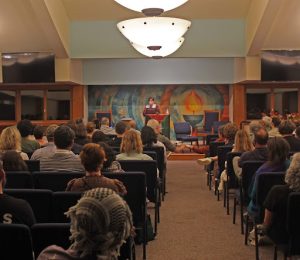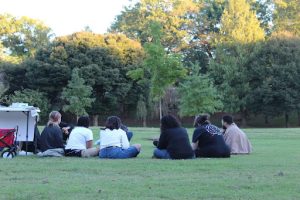University instruction surrounding COVID-19 is unclear
Students who are infected or exposed to the Omicron variant receive conflicting guidance

DeacsThrive texted out a COVID-19 exposure flowchart recommending a 10 day quarantine, in spite of CDC guidance.
January 13, 2022
Last Wednesday, just days before campus re-opened to students for the semester, I was directly exposed to COVID-19 on a university-affiliated trip. Knowing a rapid test would likely be negative since I was asymptomatic and boosted, I frantically scheduled the first PCR test I could find for Sunday afternoon. On Thursday, I left a voicemail for the Student Health Service asking for guidance and — potentially — quarantine accommodations (per a Dec. 29 email stating that “Wake Forest will provide isolation rooms for vaccinated students who test positive”) in the event I received a positive test. After networking with friends and conducting an intense search to find a testing site Friday, I waited in line for two and a half hours for drive-up PCR testing. I emailed WFU Wellness that I had been in direct contact with up to three COVID-19-positive individuals. After receiving no response, a friend who was exposed in the same setting came with me to my dorm and we continued our quarantine together in my single room in order to not expose her roommate.
Saturday afternoon, we finally received an email response from WFU Wellness: “If you wish to quarantine out of precaution, you may do so.” We were not required to do anything other than mask-up in shared spaces, nor were we offered quarantine accommodations unless we showed proof of a positive test. We continued to isolate, knowing that our direct exposures left us at high risk to contract and spread the virus. The university returned the calls of positive individuals on Sunday to contact-trace and explain that, since they were asymptomatic, they could go to class masked on Monday, just four days after testing positive for COVID-19. The most recent CDC guidelines suggest a five-day quarantine for boosted individuals who test positive, followed by five days of stringent mask-wearing. In the meantime, we left my room for the first time since Friday to take our scheduled PCR tests and returned to finish out day four of our quarantine.
Since I didn’t have any results yet, I didn’t want to risk getting a positive test result after going to class and potentially exposing my peers and professors to the virus, so I refrained from attending classes until I knew my status. And sure enough, Tuesday at 3:00 a.m., I got a text confirming that my Friday test was positive and the friend who was staying with me was negative. I immediately notified the university and got a call a few hours later from contact tracers who told me that as long as I remained asymptomatic; I could go to class as soon as I felt comfortable, then said my friend could return to her room with her roommate.
This is where I have been struggling, because I don’t know how to feel comfortable when everything I hear is contradictory and confusing. This highly-contagious virus has been ravaging our community for over two years. I have whiplash from experiencing university policies change from weekly testing, daily symptom reporting and locking up students with headaches for ten days to allowing infected students to attend class just four days after testing positive. I understand that the new CDC guidelines themselves are confusing, and I don’t blame the university for not wanting to make any rash decisions or announce guidelines that they may soon have to change. I also appreciate President Susan Wente’s emphasis on masking up and encouraging everyone to make safe choices. However, I also understand that the threat of the Omicron variant is not being taken seriously by vaccinated and boosted college-age students. A lot of students feel like COVID-19 has become politicized and many no longer feel a responsibility to keep people other than themselves safe.
The “Our Way Forward” dashboard reported 70 confirmed cases from the past two weeks, a surprising number of which were faculty and staff. Many professors are moving their classes temporarily online after their own incidents of exposure. We know that cases will continue to rise as our community attempts to return to normal, but I need the university to more clearly address what they mean by “taking care of ourselves and others,” because I’m not sure everyone is on the same page. The past week has been especially frustrating because it feels like the university hasn’t been doing enough.
I want better communication regarding expectations for students gathering and dealing with potential exposure. The Our Way Forward website needs to be updated with accurate, accessible information regarding the most recent guidelines. Outdated policies should be clearly stated as such and not shared by services such as DeacsThrive, who texted out a COVID-19 exposure flowchart recommending a 10-day quarantine for COVID-positive individuals on Monday.
Additionally, tests have been extremely hard to come by, as demands fueled by the Omicron surge have placed strains on testing centers around the state. If Wake Forest brought back testing options for students, that would alleviate some of the challenges associated with COVID-19 exposure and subsequent compliance with university policies.
I would also appreciate some reassurance and an explanation of how the current policies are in the best interest of the whole community. Wente assured us in her FDOC email that Wake Forest’s data-driven, expert-informed approach would keep us healthy and safe, but I still feel uncertain when they’re encouraging COVID-positive students to attend class and resume activities as normal. Not everyone has access to KN95 masks and not everyone is taking the same precautions outside of class. I may have been overzealous with my quarantine procedures, but I would rather be safe than sorry.
This whole situation was so stressful that I felt partially relieved when I received my positive results — I wasn’t crazy for isolating so strictly. These precautions kept my housemates and others safe from contracting COVID-19, but they were entirely my choice and the university made that very clear. As much as I wish I could rely on the spirit of (Pro Humanitate) to foster a sense of shared responsibility and compassion, the university must take a stronger stance on these health guidelines. I don’t believe that our community will survive this based on individual choices alone.












